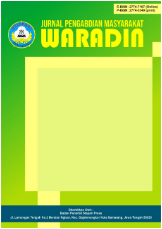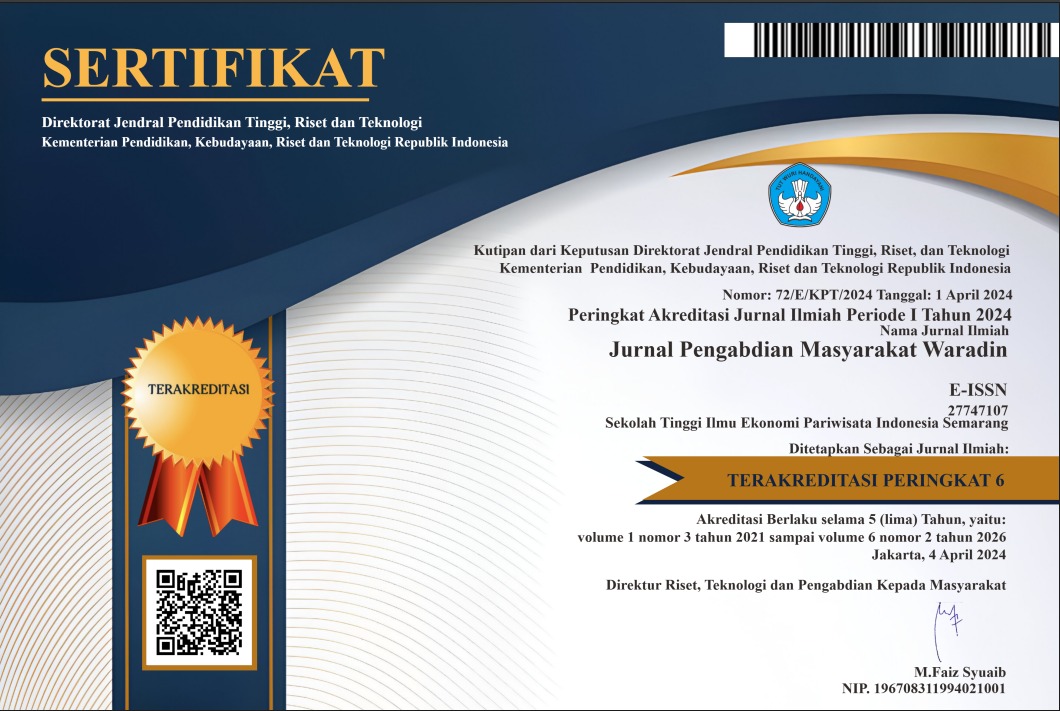Penguatan Kesadaran Lingkungan melalui Penerapan Biopestisida Eco Enzyme Di Sekolah
DOI:
https://doi.org/10.56910/wrd.v5i3.811Keywords:
Biopesticide, Eco Enzyme, Green EducationAbstract
The community service program carried out at Stella Matutina Salatiga Junior High School aims to strengthen environmental awareness while supporting the implementation of sustainable education through the manufacture of biopesticides made from eco enzymes. This activity is based on students' low understanding of the impact of the use of synthetic chemical pesticides on health and the environment. Therefore, the program is designed for students to gain hands-on experience in processing organic waste into eco enzymes and using it as the main ingredient of environmentally friendly biopesticides. The implementation method includes socialization on the importance of protecting the environment, introduction to natural biopesticides, training in making biopesticides with simple techniques, and intensive assistance to teachers and students. The evaluation process was carried out through an interactive quiz using the Kahoot application to measure participants' understanding. In addition, the follow-up of the program includes the preparation of materials, creative workshops, the development of interactive modules, teacher training, classroom implementation, and exhibitions of student works. The results of the program showed that the training was effective, as evidenced by the application of biopesticides in school parks and the increase in student knowledge, namely from a pre-test score of 53% to 59% in the post-test. These findings confirm that the application of eco enzymes is not only beneficial in reducing the use of chemical pesticides, but also able to foster students' environmental awareness and practical skills. In the future, this program has the potential to be replicated in other schools as a project-based learning model that is applicable and sustainable.
References
Astuti, A. P., Syeptiani, S., dan Listiono, A. E. (2024). Penerapan Model Pembelajaran Project Based Learning dalam Kegiatan Daur Ulang. Jurnal Perspektif Pendidikan, 18(2), 232–243. https://doi.org/10.31540/jpp.v18i2.3299
Ayu Puspita Dewi, Mira Asmiranda, S. A. (2024). Pendidikan Karakter Peduli Lingkungan dan Menjaga Kebersihan Di Sekolah. Cendikia Jurnal Pendidikan dan Pengajaran, 2(3), 454–474.
Caecilia Setiawati, M. N., Munisih, S., Soendoro, A. K., Mutmainah, Haryanti, S., Bagiana, K., Puspitaningrum, I., R, U., dan DF, Y. (2023). Pembuatan Eco-Enzyme Dan Pemanfaatannya Untuk Gel Anti Nyamuk Di Desa Ngrawan Kecamatan Getasan Kabupaten Semarang. Jurnal Pengabdian Kesehatan, 6(3), 214–221. https://jpk.jurnal.stikescendekiautamakudus.ac.id/index.php/jpk/article/view/289
Fatia Rizki Nuraini, Nina Difla Muflikhah, S. N. (2021). Jurnal abdi insani. Jurnal Abdi Insani, 9(September), 1125–1134.
Fitriyah, R., dan Arifqi, M. M. (2024). Green Economy Sebagai Konsep Sustinable Development di Kabupaten Sumenep. Jurnal Pembangunan Sumenep, 4(1), 20–34. www.iesr.or.id
Hidayah, N., Rahma, N., Amelia, R., Kumala, R., Meliandika, O., dan Asmadi, T. (2024). Pemanfaatan Daun Mimba (Azadirachta indica) Sebagai Pestisida Nabati Dalam Mengatasi Masalah Hama di Desa Gondang Kecamatan Gangga Kabupaten Lombok Utara. Jurnal Pengabdian Magister Pendidikan IPA, 7(1), 308–311. https://doi.org/10.29303/jpmpi.v7i1.6527
Huda, H., Fathoni, R., dan Larasati, T. D. (2022). Pemanfaatan Dan Penyuluhan Serai Menjadi Semprotan Anti Nyamuk Kepada Masyarakat. Prosiding Pengabdian ReTII, x, 87–92.
Kristiananda, D., Allo, J. L., Widyarahma, V. A., Lusiana, L., Noverita, J. M., Octa Riswanto, F. D., dan Setyaningsih, D. (2022). Aktivitas Bawang Putih (Allium Sativum L.) Sebagai Agen Antibakteri. Jurnal Ilmu Farmasi dan Farmasi Klinik, 19(1), 46. https://doi.org/10.31942/jiffk.v19i1.6683
Pusparani, D., dan Miranto, S. (2021). Hubungan Konsep Diri dan Pengetahuan Lingkungan dengan Sikap Peduli Lingkungan Peserta Didik di SMA. EduBiologia: Biological Science and Education Journal, 1(2), 134. https://doi.org/10.30998/edubiologia.v1i2.9956
Putranti, H. R. D., Danang, D., Da Silva, T. M. F. B., dan Pujiati, A. A. B. (2025). Integrating Hands-on and Virtual Learning for Environmental Sustainability: Eco Enzyme Soap Making at SMP Stela Martutina. REKA ELKOMIKA: Jurnal Pengabdian kepada Masyarakat, 6(1), 88–97.
Rozi, F., Zubaidi, A., dan Masykuroh, M. (2021). Strategi Kepala Sekolah dalam Menerapkan Program Perilaku Hidup Bersih dan Sehat (PHBS) pada Anak Usia Dini. Jurnal Pendidikan Anak, 10(1), 59–68. https://doi.org/10.21831/jpa.v10i1.39788
Sinambela, B. R. (2024). Dampak Penggunaan Pestisida Dalam Kegiatan Pertanian Terhadap Lingkungan Hidup Dan Kesehatan. AGROTEK: Jurnal Ilmiah Ilmu Pertanian, 8(1), 76–85. https://doi.org/10.33096/agrotek.v8i1.478
Sipahutar, S. W., Nababan, C. F., Sagala, G. S., Sihombing, A. T., Simanjuntak, G., dan Sihombing, R. (2021). Peningkatan Kesadaran dan Partisipasi Masyarakat Melalui Program Rutin Sabtu Bersih di Kelurahan Tanjung Sari. Pemberdayaan Masyarakat: Jurnal Aksi Sosial, 48(2), 39–62. www.ine.es
Teodora Dasilva, Syntia Nabila, Mega Kasmiyatun, Ery Fatarina Purwaningtyas, dan Priyono Kusumo. (2024). Optimasi Waktu Reaksi dan pH terhadap Peningkatan Yield Eco Enzyme. Jurnal Sains dan Teknologi, 3(2), 102–110. https://doi.org/10.58169/saintek.v3i2.672
Website https://sipsn.menlhk.go.id/sipsn/public/data/timbulan diakses pada tanggal 31 Agustus 2025, pukul 23.06 WIB







